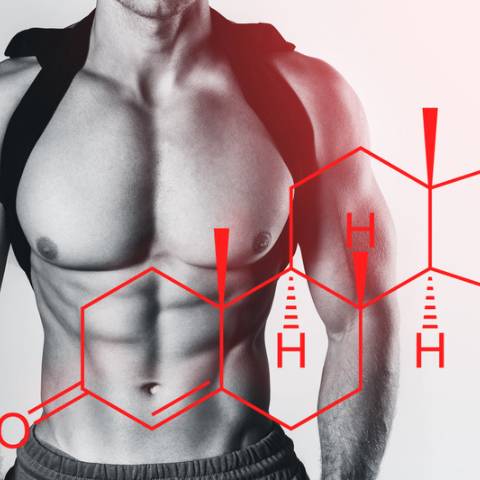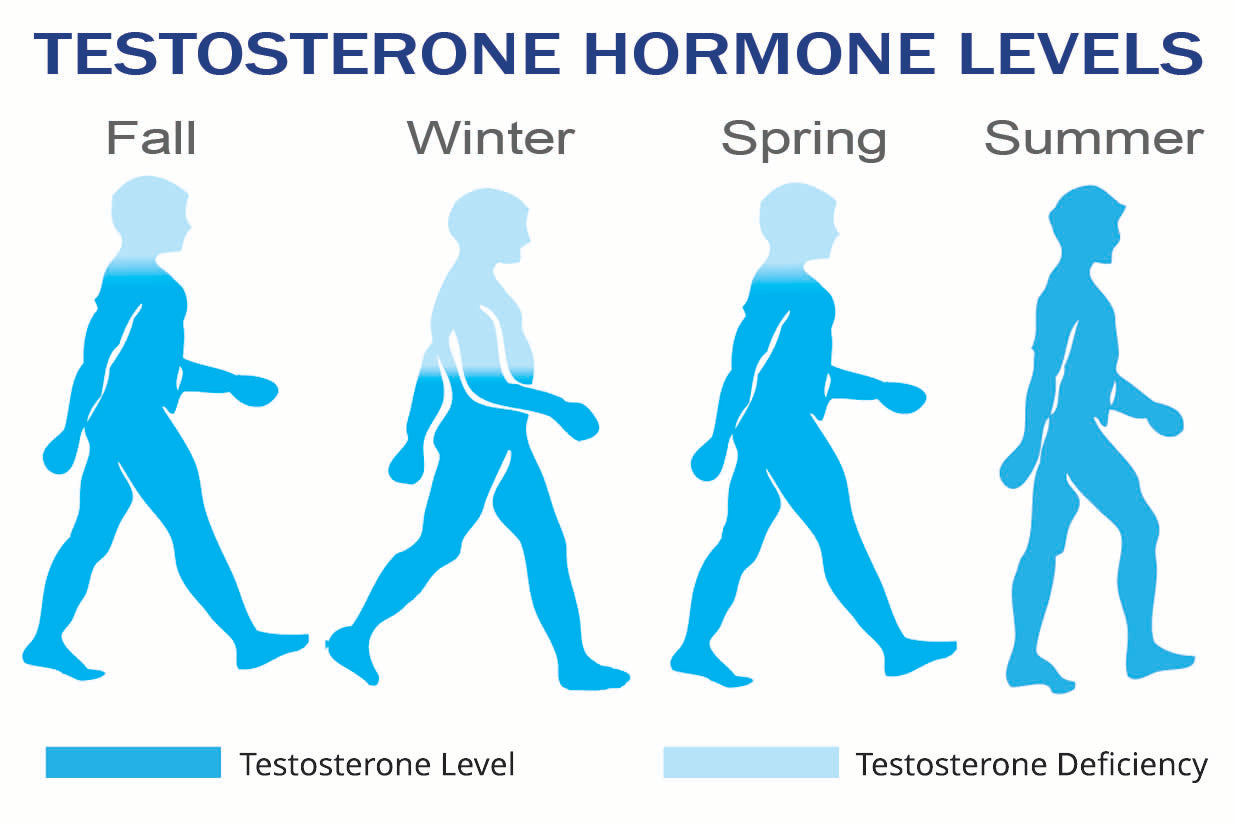What is Testosterone?

Testosterone is the primary sex and anabolic hormone in males. It’s vital role is to promote the development of male reproductive system organs like the prostate and testes. In addition, it encourages the development of male sex characteristics such as building muscle mass and growth of body hair.
Testosterone is produced by the testes and gives men their characteristic deep voice, muscles, and facial hair. In addition, testosterone boost mood, promotes bone strength, and aids thinking ability.
Age-Related fall in testosterone Levels
According to scientific research, testosterone decline with age is inevitable. Because of this age-related decline, the low testosterone level in old males has been commonly referred to as "Male Menopause." However, in males, this does not occur quickly as in females. Instead, testosterone levels fall gradually over a long time.
In normal males, testosterone levels are high during adolescence or puberty and early adulthood. However, after 30 years of age, the levels start declining.

The prevalence of biochemical testosterone decline increases with aging. This decline is also associated with illnesses and debilitation that come with aging. Some male patients with low testosterone levels present with symptoms of aging. This phenomenon has raised eyebrows as to whether some of the manifestations of aging result from low testosterone. Some of the presentations that cut across include low energy levels, tiredness, low libido, decreased sexual performance, mood changes, and depression.
Unfortunately, the overlap in clinical presentation has made the diagnosis of hypogonadism in aging men difficult.
Furthermore, several significant clinical findings and disease states are linked to low testosterone. These disease states include Alzheimer's disease, obesity, frailty, hypercholesterolemia, heart diseases, and high blood pressure.
The extent of involvement of testosterone in the development of these diseases and how testosterone supplementation could be useful is an important question to modern researchers.
Why does testosterone level fall with age?
Age-related hypogonadism may occur due to two reasons;
- Primary hypogonadism or testicular failure: primary hypogonadism refers to a problem in the testes, such as testicular atrophy. As men age, testicular cells reduces in number, leading to atrophy. Atrophy can lead to low levels of circulating levels of testosterone.
- Secondary hypogonadism or hypothalamic-pituitary axis failure: secondary hypogonadism occurs with diseases of the hypothalamus and pituitary glands.
In primary hypogonadism, the testicles are diseased but the hypothalamic-pituitary axis is normal. On the other hand, there is dysfunction of the hypothalamic-pituitary pathway in secondary hypothyroidism with normal testicles.

Symptoms of Low Testosterone
Since testosterone decline occurs gradually, the signs and symptoms of low testosterone levels are not obvious. Again, low testosterone can present as obesity, psychological stress, substance use, and solid organ dysfunction.
Sexual Symptoms
Testosterone is the primary hormone in driving sexual desire and libido. Therefore, a decline in testosterone levels with age will mean progressive loss of libido suppose there is no intervention with supplements. One of the most significant worries of aging men is declining sexual desire and performance. Indeed, this can bring a client to the gynecologist.
As men age, they can manifest sex function-related issues that can come about due to low testosterone levels. This includes a low desire for sex, fewer erections, and infertility. However, these manifestations do not occur suddenly; thus, if you note them suddenly, low testosterone is not the only cause.
Physical changes
Several physical changes can occur as testosterone levels fall with age. Testosterone is responsible for increasing muscle mass and body hair. In general, it contributes significantly to the masculine nature of men. As testosterone levels decline, the reverse is seen. The most common physical changes of age-related hypogonadism are;
- Increases fatigue
- Hot flashes
- Decrease in the amount of body hair
- Bone fragility
- Increased body fat
- Tenderness and swelling over the breast tissue
- Decreased muscle mass and strength
Changes in sleep pattern
Low testosterone levels can lead to loss of sleep (insomnia) and other changes to the sleep pattern.
Emotional disturbances
Low testosterone level leads to feelings of sadness and depression. In addition, low testosterone levels may lead to poor concentration, memory dysfunction, and low self-esteem and confidence. These effects come about because of irritability, low sex drive, and fatigue accompanying low testosterone.
How is a diagnosis of low testosterone made?

Like any medical condition, making a diagnosis of low testosterone requires extensive history taking, physical examination, lab investigations, and to some extent, imaging. Imaging and investigations will rule out organic causes of hypogonadism. Physical examination is also essential since it will help a clinician diagnose organic disorders like liver, thyroid, and kidney disease that may cause low testosterone levels.
After inquiring about the symptoms and doing a thorough physical examination, a doctor will also measure the level of testosterone in your blood. Testosterone levels usually vary throughout the day, but an early morning test is preferred since they are high in the morning.
Causes of low testosterone levels
Apart from age, here are the other causes of low testosterone levels in males:
- Head injury: head injury may affect the hypothalamus and the pituitary function. Traumatic head injury may lead to the dysfunction of the hypothalamus and pituitary whose end result is low low testosterone.
- Chemotherapy for cancer treatment.
- Metabolic disorders like hemochromatosis.
- Liver diseases such as cirrhosis.
- Thyroid disorders like hypothyroidism (low thyroid hormone levels in the blood)
- Tumor of the pituitary gland.
- Acute or chronic illnesses.
- Chronic kidney disease (Kidney dysfunction lasting more than three months).
- Inflammatory conditions such as sarcoidosis. Sarcoidosis is a medical condition that causes inflammation of the lungs.
- Abnormalities in the hypothalamus, a gland in the brain that controls the secretory function of other glands, including the testes
- Malnutrition: malnutrition can be in the form of either obesity or weight loss. Both of these disorders can cause hypogonadism in males.
- Radiation exposure or prior brain surgery
Treatment of low Testosterone
Men can have low testosterone levels with no symptoms. In such cases, we recommend no treatment. However, if you have low testosterone levels with symptoms like sexual dysfunction and fatigue, testosterone replacement therapy is crucial.
Again, even if you have a low testosterone level with symptoms, testosterone replacement therapy should not be your first line of treatment. Before starting replacement therapy, it is prudent to identify and treat treatable causes like liver, kidney, and thyroid disease before opting for hormone replacement.
Hormone replacement is a choice you must make with your doctor by weighing the potential risks and benefits. There are several therapy options that you may consider; they include:
Gels
You can spread topical testosterone gels onto the skin of the shoulders, arms, forearm, legs, or thighs. After applying the gels, wash your hands and cover the area with a piece of cloth to avoid exposing others to testosterone.
Use of a skin patch
You can also apply a testosterone skin patch once daily. However, we usually recommend evening applications. Skin patches slowly release testosterone into the skin for systemic absorption in small doses.
Injections
Several testosterone injectables are given every 14 days. Following injection, testosterone levels rise to peak levels before they fall again. This brings about a roller-coaster effect that manifests with a spike in mood and energy levels that trails off.
Pellets
Testosterone pellets are implanted under the skin of the buttock and thighs. Pellets can stay in situ for three to six months, after which they are replaced. The pellets release a small amount of testosterone throughout this period into circulation.
Upon initiation of therapy, men recognize improvement within 4-6 weeks of medications. However, it may take three to six months to improve muscle mass.
Oral therapy
Oral therapy is in tablets or capsules. Tablets can be attached to the gums or inner cheeks twice a day. On the other hand, capsules are swallowed for gastrointestinal absorption. In the oral cavity, testosterone is absorbed directly into the bloodstream by the mucosa of the oral cavity.
Advantages of testosterone replacement therapy
The testosterone replacement results are variable and impossible to predict since our bodies respond differently. Despite the variation, a large percentage of men experience the following positive responses;
- Improvement in mood
- Increase in bone density
- Increase in muscle mass
- Enhancement of insulin sensitivity
- Improvement in mood, memory, thought, and concentration
Downsides of testosterone replacement
Although testosterone replacement has several advantages for men, its use has a few downsides and contraindications. The use of testosterone replacement therapy may lead to the development of acne, rash, itching, and irritation at the site of application.
Many researchers agree that testosterone replacement therapy's benefits and side effects are yet to be fully unmasked.
Contraindications
You should avoid using testosterone replacement therapy if you have any of the following health conditions;
- History of blood clots: either pulmonary embolism or deep vein thrombosis
- Congestive heart failure: the use of exogenous testosterone can worsen heart failure symptoms.
- Sleep apnea.
- Prostate cancer
- Benign prostate hypertrophy
In summary, testosterone is a hormone responsible for manly features. It is secreted from the testes. With age, its level falls due to testicular atrophy (primary hypogonadism) or hypothalamic-pituitary disorders. Suppose deficiency causes symptoms, a doctor can prescribe exogenous testosterone.



